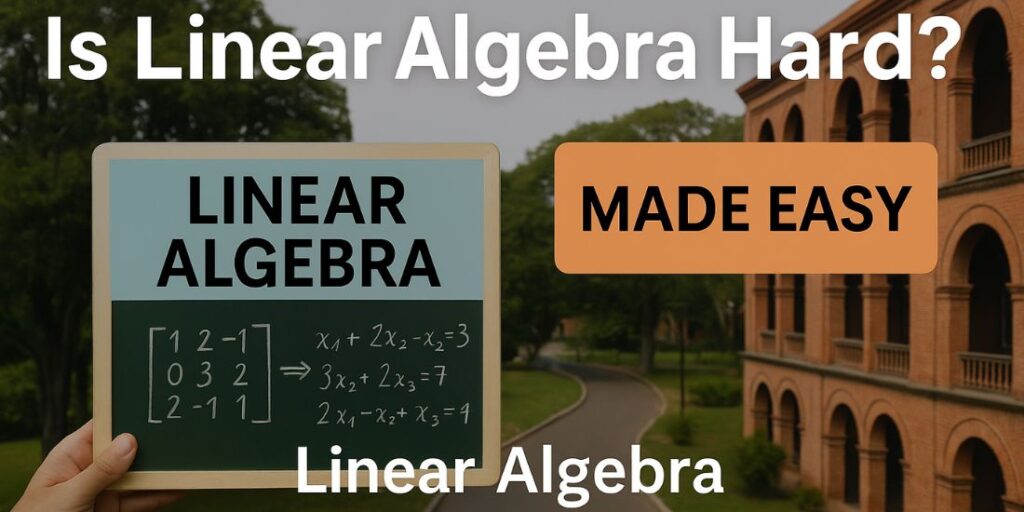Linear Algebra often has a reputation among students as one of the more challenging branches of mathematics. The abstract concepts, symbolic notation, and non-intuitive nature frequently lead learners to question, “Is Linear Algebra Hard?” While many students grapple with this perception, a deeper exploration into the Essence of Linear Algebra reveals not just clarity, but beauty and profound practicality.
One of the most revolutionary resources available today is the visual educational series known as 3Blue1Brown Essence of Linear Algebra by Grant Sanderson. This series has transformed the way countless students approach linear algebra, changing confusion and intimidation into fascination and comprehension. This article explores how this approach illuminates the core concepts of Linear Algebra, provides practical Linear Algebra Solutions, and answers the common question—why is Linear Algebra perceived as hard?
What is the Essence of Linear Algebra?
The essence of Linear Algebra lies in its fundamental role as the mathematics of vectors and matrices, serving as a powerful language describing systems and transformations. At its core, Linear Algebra revolves around vectors, vector spaces, linear transformations, and the properties of matrices—far beyond merely solving equations.
Instead of seeing matrices as intimidating grids of numbers, understanding the essence involves perceiving them as transformative operators that reshape vector spaces. Each matrix embodies a specific transformation—such as rotation, scaling, or shearing—that alters the shape, size, and orientation of vector spaces.
Why Do Students Find Linear Algebra Hard?

The question “Is Linear Algebra Hard?” arises frequently because the subject represents a substantial shift from computational mathematics, such as algebra and calculus, to conceptual mathematics. Students accustomed to direct problem-solving might struggle with abstract ideas like vector spaces and linear independence. Key reasons for the perceived difficulty include:
1. Abstract and Non-Intuitive Concepts
Linear Algebra introduces abstract concepts such as vector spaces, subspaces, linear independence, and eigenvectors, which may initially seem disconnected from real-world experiences.
2. Symbol-Heavy Notation
The notation in Linear Algebra can feel overwhelming at first. Matrices, vectors, determinants, and transformations all have their symbols and rules.
3. Logical and Proof-Based Approach
Unlike simpler mathematics, Linear Algebra demands logical reasoning and proof-based understanding, pushing students to grasp underlying concepts rather than memorize procedures.
3Blue1Brown Essence of Linear Algebra: Revolutionizing Understanding
Grant Sanderson, known as 3Blue1Brown, recognized these challenges and created a groundbreaking visual explanation series, the “Essence of Linear Algebra.” This series emphasizes intuition, visualization, and conceptual understanding over procedural memorization.
Visual Learning Approach
3Blue1Brown uses animations and intuitive visuals, demonstrating how linear transformations work graphically. By visualizing how vectors and matrices interact, students gain a deeper intuitive understanding of the abstract concepts.
Core Topics Explored in the Series
- Vectors and Vector Spaces: Visual representation of vectors, linear combinations, and basis.
- Matrices and Linear Transformations: Understanding matrices as transformations and seeing their impact visually.
- Eigenvalues and Eigenvectors: Demonstrating the concept of vectors that remain aligned after transformations.
- Determinants and Matrix Operations: Intuitively explaining matrix determinants and their geometric implications.
Practical Linear Algebra Solutions
Effective understanding requires not just theory but practice. Practical Linear Algebra Solutions complement conceptual learning by reinforcing intuition through problem-solving. Key strategies include:
Using Computational Tools
Software like Python (NumPy), MATLAB, and Wolfram Alpha provide powerful ways to visualize and solve linear algebra problems interactively. These tools allow experimentation, making abstract ideas concrete and tangible.
Relating to Real-World Applications
Linear Algebra is foundational in modern technology. Applications in data science, machine learning, quantum computing, computer graphics, and economics show its practical importance, motivating students to master its concepts.
Building Conceptual Clarity
Instead of rote memorization, emphasize understanding core definitions, such as vector space, linear independence, and eigenvectors. Connecting these concepts visually, as demonstrated by 3Blue1Brown, enhances retention and comprehension.
How the Essence of Linear Algebra Makes the Subject Easier
The transformative approach provided by the Essence of Linear Algebra series addresses why students find Linear Algebra challenging. By visualizing abstract concepts, the series demystifies the subject, turning abstract definitions into intuitive knowledge.
Breaking Down Complexity
Visualization breaks complex concepts down into manageable components. Rather than abstract algebraic manipulation, visual tools provide a clear and intuitive understanding of mathematical processes.
Fostering Curiosity and Engagement
When students see the beauty and practical significance of Linear Algebra visually, their curiosity grows, driving deeper engagement and meaningful learning.
Facilitating Long-term Retention
Visual learning is powerful for long-term retention. Students who visualize mathematical transformations and structures develop stronger memory connections, retaining knowledge far longer than those who rely solely on rote memorization.
Conclusion: Rediscovering Linear Algebra
Linear Algebra need not be the daunting subject many perceive it to be. By focusing on the essence—understanding vectors, transformations, and their visual interactions—students can overcome initial challenges. Resources like the 3Blue1Brown Essence of Linear Algebra series play a critical role in reshaping students’ perceptions, providing powerful visual intuitions, and practical solutions.
In embracing the essence of linear algebra, students not only enhance their mathematical capabilities but also prepare themselves for applications in technology and science. It becomes evident that the beauty of linear algebra lies not in its complexity, but in its elegant simplicity and remarkable applicability.
This exploration of the Essence of Linear Algebra is proudly presented by Pure Acad, dedicated to fostering deep, intuitive learning.









